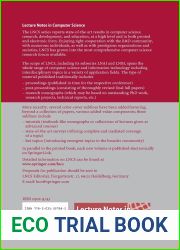
BOOKS - Software Design for Resilient Computer Systems 3rd Edition

Software Design for Resilient Computer Systems 3rd Edition
Author: Igor Schagaev, Jurg Gutknecht
Year: 2024
Pages: 414
Format: PDF
File size: 14.3 MB
Language: ENG

Year: 2024
Pages: 414
Format: PDF
File size: 14.3 MB
Language: ENG

Book Description: Software Design for Resilient Computer Systems 3rd Edition In today's fast-paced technological world, the need for resilient computer systems that can adapt to changing conditions and recover from failures is more important than ever. This third edition of Software Design for Resilient Computer Systems provides a comprehensive guide to designing software that can tolerate faults and ensure highest reliability. With a new introductory chapter, the book is ideal for both researchers and industry professionals who want to understand the latest advancements in software resilience. The authors begin by explaining how system software interacts with hardware to tolerate faults, analyzing and developing the theory of fault tolerance to increase the reliability of a system. They introduce the theory of redundancy and its use in constructing subsystems through a general algorithm of fault tolerance (GAFT) and apply it to distributed systems. The book's approach is applied to various hardware subsystems, such as different structures of RAM and processor cores, demonstrating exceptional performance, reliability, and energy efficiency. The book covers a wide range of industries and research areas, including military aviation, intensive healthcare, industrial control, and space exploration. It addresses the question of how system software should be designed to account for faults and which fault tolerance features should be prioritized for highest reliability.
Разработка программного обеспечения для отказоустойчивых компьютерных систем 3-я редакция В современном быстро развивающемся технологическом мире потребность в отказоустойчивых компьютерных системах, способных адаптироваться к изменяющимся условиям и восстанавливаться после сбоев, важнее, чем когда-либо. Это третье издание Software Design for Resilient Computer Systems (Разработка программного обеспечения для отказоустойчивых компьютерных систем) содержит исчерпывающее руководство по разработке программного обеспечения, способного выдерживать сбои и обеспечивать высочайшую надежность. С новой вводной главой книга идеально подходит как для исследователей, так и для профессионалов отрасли, которые хотят понять последние достижения в области устойчивости программного обеспечения. Авторы начинают с объяснения того, как системное программное обеспечение взаимодействует с аппаратным обеспечением, чтобы допускать сбои, анализируя и развивая теорию отказоустойчивости для повышения надежности системы. Они вводят теорию избыточности и её использование при построении подсистем через общий алгоритм отказоустойчивости (GAFT) и применяют её к распределённым системам. Подход книги применяется к различным аппаратным подсистемам, таким как различные структуры оперативной памяти и процессорных ядер, демонстрируя исключительную производительность, надежность и энергоэффективность. Книга охватывает широкий спектр отраслей и областей исследований, включая военную авиацию, интенсивное здравоохранение, промышленный контроль и освоение космоса. В нем рассматривается вопрос о том, как следует проектировать системное программное обеспечение для учета сбоев и какие функции отказоустойчивости должны быть приоритетными для обеспечения высочайшей надежности.
Développement de logiciels pour systèmes informatiques tolérants aux pannes 3ème édition Dans le monde technologique en évolution rapide d'aujourd'hui, le besoin de systèmes informatiques tolérants aux pannes capables de s'adapter aux conditions changeantes et de se remettre des pannes est plus important que jamais. Cette troisième édition de Software Design for Resilient Computer Systems (Développement de logiciels pour systèmes informatiques tolérants aux pannes) contient un guide complet pour développer des logiciels capables de résister aux pannes et d'assurer la plus haute fiabilité. Avec un nouveau chapitre d'introduction, le livre est idéal pour les chercheurs et les professionnels de l'industrie qui veulent comprendre les dernières avancées en matière de durabilité du logiciel. s auteurs commencent par expliquer comment le logiciel système interagit avec le matériel pour permettre les pannes en analysant et en développant la théorie de la tolérance aux pannes pour améliorer la fiabilité du système. Ils introduisent la théorie de la redondance et son utilisation dans la construction de sous-systèmes par l'intermédiaire de l'algorithme général de tolérance aux pannes (GAFT) et l'appliquent aux systèmes distribués. L'approche du livre s'applique à différents sous-systèmes matériels, tels que les différentes structures de RAM et les cœurs de traitement, montrant des performances exceptionnelles, la fiabilité et l'efficacité énergétique. livre couvre un large éventail d'industries et de domaines de recherche, y compris l'aviation militaire, la santé intensive, le contrôle industriel et l'exploration spatiale. Il examine la façon dont le logiciel du système devrait être conçu pour tenir compte des pannes et quelles fonctions de tolérance aux pannes devraient être prioritaires pour assurer la plus haute fiabilité.
Desarrollo de software para sistemas informáticos tolerantes a fallas 3ª edición En el mundo tecnológico en rápida evolución de hoy, la necesidad de sistemas informáticos tolerantes a fallas capaces de adaptarse a condiciones cambiantes y recuperarse de fallos es más importante que nunca. Esta tercera edición de Software Design for Resilient Computer Systems (Desarrollo de software para sistemas informáticos tolerantes a fallas) ofrece una guía exhaustiva para el desarrollo de software capaz de soportar fallos y proporcionar la máxima confiabilidad. Con un nuevo capítulo introductorio, el libro es ideal tanto para investigadores como para profesionales de la industria que quieran comprender los últimos avances en sostenibilidad del software. autores comienzan explicando cómo el software del sistema interactúa con el hardware para permitir fallas, analizando y desarrollando la teoría de la tolerancia a fallas para mejorar la confiabilidad del sistema. Introducen la teoría de la redundancia y su uso en la construcción de subsistemas a través del algoritmo general de tolerancia a fallas (GAFT) y la aplican a sistemas distribuidos. enfoque del libro se aplica a diferentes subsistemas de hardware, como diferentes estructuras de RAM y núcleos de procesador, lo que demuestra un rendimiento excepcional, confiabilidad y eficiencia energética. libro cubre una amplia gama de industrias y áreas de investigación, incluyendo aviación militar, salud intensiva, control industrial y exploración espacial. En él se examina la forma en que debe diseñarse el software del sistema para hacer frente a las fallas y qué características de tolerancia a las fallas deben ser prioritarias para garantizar la máxima fiabilidad.
Sviluppo di software per sistemi informatici a batteria 3 ° edizione In un mondo tecnologico in continua evoluzione, è più importante che mai la necessità di sistemi informatici in grado di adattarsi alle condizioni in evoluzione e ripristinare i problemi. Questa terza edizione di Software Design for Resilient Computer Systems offre una guida completa allo sviluppo di software in grado di gestire i guasti e garantire la massima affidabilità. Con un nuovo capitolo introduttivo, il libro è ideale sia per i ricercatori che per i professionisti del settore che vogliono comprendere gli ultimi progressi nel campo della sostenibilità del software. Gli autori iniziano spiegando come il software di sistema interagisce con l'hardware per consentire i guasti, analizzando e sviluppando la teoria della resistenza per migliorare l'affidabilità del sistema. Introducono la teoria della ridondanza e il suo utilizzo per la costruzione dei sottosistemi attraverso un algoritmo di tolleranza comune (GAFT) e la applicano ai sistemi distribuiti. L'approccio della libreria si applica a diversi sottosistemi hardware, come le diverse strutture di RAM e core processori, dimostrando prestazioni, affidabilità ed efficienza energetica eccezionali. Il libro comprende una vasta gamma di settori e ambiti di ricerca, tra cui l'aeronautica militare, l'assistenza sanitaria intensiva, il controllo industriale e l'esplorazione dello spazio. Esamina come progettare il software di sistema per la gestione dei guasti e quali funzioni di disponibilità devono essere prioritarie per garantire la massima affidabilità.
Software-Entwicklung für ausfallsichere Computersysteme 3. Auflage In der heutigen schnelllebigen technologischen Welt ist der Bedarf an ausfallsicheren Computersystemen, die sich an veränderte Bedingungen anpassen und sich von Ausfällen erholen können, wichtiger denn je. Diese dritte Ausgabe von Software Design for Resilient Computer Systems (Softwareentwicklung für ausfallsichere Computersysteme) enthält eine umfassende Anleitung zur Entwicklung von Software, die Störungen standhält und höchste Zuverlässigkeit bietet. Mit dem neuen Einführungskapitel ist das Buch sowohl für Forscher als auch für Branchenexperten ideal, die die neuesten Fortschritte in der Software-Nachhaltigkeit verstehen wollen. Die Autoren erklären zunächst, wie die Systemsoftware mit der Hardware interagiert, um Fehler zuzulassen, indem sie die Fehlertoleranztheorie analysieren und weiterentwickeln, um die Zuverlässigkeit des Systems zu verbessern. e führen die Redundanztheorie und ihre Verwendung beim Aufbau von Subsystemen durch einen generischen Failsafe-Algorithmus (GAFT) ein und wenden sie auf verteilte Systeme an. Der Ansatz des Buches wird auf verschiedene Hardware-Subsysteme wie verschiedene RAM-Strukturen und Prozessorkerne angewendet und zeigt außergewöhnliche istung, Zuverlässigkeit und Energieeffizienz. Das Buch deckt ein breites Spektrum von Branchen und Forschungsbereichen ab, darunter militärische Luftfahrt, intensives Gesundheitswesen, industrielle Kontrolle und Weltraumforschung. Dabei geht es um die Frage, wie die Systemsoftware für die Störungsrechnung ausgelegt werden soll und welche Fehlertoleranzfunktionen priorisiert werden müssen, um höchste Zuverlässigkeit zu gewährleisten.
Software Development for Fault-Tolerant Computer Systems 3rd Edition W dzisiejszym szybko rozwijającym się świecie technologicznym, potrzeba systemów komputerowych odpornych na usterki, które mogą dostosować się do zmieniających się warunków i wyzdrowieć z awarii, jest ważniejsza niż kiedykolwiek. Ta trzecia edycja Software Design for Resilient Computer Systems zapewnia kompleksowy przewodnik po tworzeniu oprogramowania, które może wytrzymać awarie i zapewnić najwyższą niezawodność. Dzięki nowemu rozdziałowi wprowadzającemu książka jest idealna zarówno dla naukowców, jak i specjalistów z branży, którzy chcą zrozumieć najnowsze osiągnięcia w zakresie zrównoważonego rozwoju oprogramowania. Autorzy zaczynają od wyjaśnienia, w jaki sposób oprogramowanie systemowe oddziałuje z sprzętem, aby umożliwić awarie, analizę i rozwój teorii tolerancji błędów w celu poprawy niezawodności systemu. Wprowadzają one teorię redundancji i jej zastosowanie w podsystemach budowlanych poprzez algorytm ogólnej tolerancji uszkodzeń (GAFT) i stosują ją do systemów rozproszonych. Podejście książki dotyczy różnych podsystemów sprzętu, takich jak różne struktury RAM i rdzeni procesorów, wykazujących wyjątkową wydajność, niezawodność i efektywność energetyczną. Książka obejmuje szeroką gamę branż i obszarów badawczych, w tym lotnictwo wojskowe, intensywną opiekę zdrowotną, kontrolę przemysłową i eksplorację przestrzeni kosmicznej. Omówiono w nim, w jaki sposób oprogramowanie systemowe powinno być zaprojektowane tak, aby uwzględniało awarie i jakie cechy tolerancji błędów powinny być traktowane priorytetowo, aby zapewnić najwyższą niezawodność.
''
Hataya Dayanıklı Bilgisayar stemleri için Yazılım Geliştirme 3rd Edition Günümüzün hızla gelişen teknolojik dünyasında, değişen koşullara uyum sağlayabilen ve arızalardan kurtulabilen hataya dayanıklı bilgisayar sistemlerine duyulan ihtiyaç her zamankinden daha önemlidir. Esnek Bilgisayar stemleri için Yazılım Tasarımı'nın bu üçüncü baskısı, arızalara dayanabilecek ve en yüksek güvenilirliği sağlayabilecek yazılım geliştirmek için kapsamlı bir rehber sunmaktadır. Yeni bir giriş bölümüyle kitap, yazılım sürdürülebilirliğindeki en son gelişmeleri anlamak isteyen araştırmacılar ve endüstri profesyonelleri için idealdir. Yazarlar, sistem yazılımının arızalara izin vermek için donanımla nasıl etkileşime girdiğini açıklayarak, sistem güvenilirliğini artırmak için hata tolerans teorisini analiz ederek ve geliştirerek başlar. Artıklık teorisini ve alt sistemlerin oluşturulmasında kullanımını genel bir hata tolerans algoritması (GAFT) aracılığıyla tanıtır ve dağıtılmış sistemlere uygularlar. Kitabın yaklaşımı, olağanüstü performans, güvenilirlik ve enerji verimliliği gösteren çeşitli RAM yapıları ve işlemci çekirdekleri gibi çeşitli donanım alt sistemleri için geçerlidir. Kitap, askeri havacılık, yoğun sağlık hizmetleri, endüstriyel kontrol ve uzay araştırmaları da dahil olmak üzere çok çeşitli endüstrileri ve araştırma alanlarını kapsamaktadır. stem yazılımının arızaları hesaba katmak için nasıl tasarlanması gerektiğini ve en yüksek güvenilirliği sağlamak için hangi hata toleransı özelliklerine öncelik verilmesi gerektiğini tartışır.
تطوير برامج | لأنظمة الكمبيوتر المتسامحة مع الأخطاء الإصدار الثالث في العالم التكنولوجي سريع التطور اليوم، أصبحت الحاجة إلى أنظمة كمبيوتر تتحمل الأخطاء يمكنها التكيف مع الظروف المتغيرة والتعافي من الإخفاقات أكثر أهمية من أي وقت مضى. توفر هذه النسخة الثالثة من Software Design for Resilient Computer Systems دليلاً شاملاً لتطوير البرامج التي يمكنها تحمل الإخفاقات وتوفير أعلى درجات الموثوقية. مع فصل تمهيدي جديد، يعد الكتاب مثاليًا لكل من الباحثين والمتخصصين في الصناعة الذين يرغبون في فهم أحدث التطورات في استدامة البرامج. يبدأ المؤلفون بشرح كيفية تفاعل برامج النظام مع الأجهزة للسماح بالفشل وتحليل وتطوير نظرية تحمل الأخطاء لتحسين موثوقية النظام. يقدمون نظرية التكرار واستخدامها في بناء الأنظمة الفرعية من خلال خوارزمية عامة لتحمل الأخطاء (GAFT) وتطبيقها على الأنظمة الموزعة. ينطبق نهج الكتاب على مختلف الأنظمة الفرعية للأجهزة، مثل الهياكل المختلفة لذاكرة الوصول العشوائي ونوى المعالج، مما يدل على الأداء الاستثنائي والموثوقية وكفاءة الطاقة. يغطي الكتاب مجموعة واسعة من الصناعات ومجالات البحث، بما في ذلك الطيران العسكري والرعاية الصحية المكثفة والتحكم الصناعي واستكشاف الفضاء. يناقش كيف يجب تصميم برامج النظام لحساب الإخفاقات وما هي ميزات تحمل الأخطاء التي يجب إعطاؤها الأولوية لضمان أعلى موثوقية.

















































